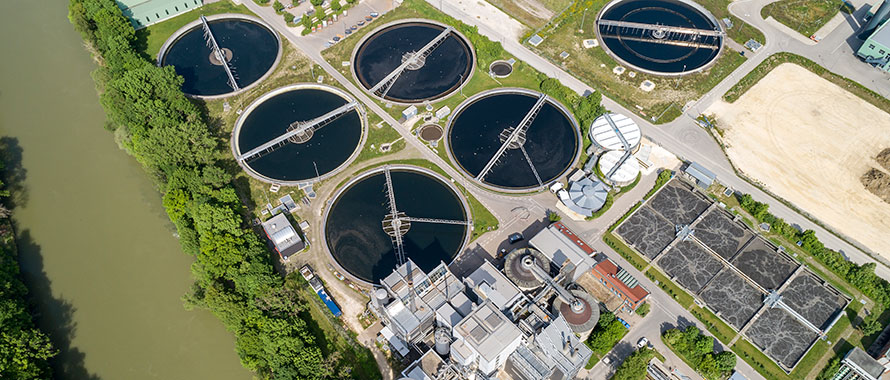Featured Solutions
The sewage was in the process of being treated but had not yet reached the final stage of disinfection when a pump failure occurred, CBS News reported. According to the city, the warning to stay out of the river was given “out of an abundance of caution.”
“Accidents happen,” said Timothy Donnellon, Senior Broker, Environmental, Burns & Wilcox, Charleston, South Carolina. “Fortunately, they were at the last step of the treatment process, but it goes to show you that even at what I would assume is a well-run sewage treatment plant, things like this can happen.”

It is definitely a cautionary tale. This incident speaks very clearly and very loudly to why this type of client should really contemplate having environmental coverage in place.
Potential impacts from the leak include illnesses caused by higher levels of bacteria, harm to area aquatic life, and disruption of business activities along the river. Pollution-related damages are generally excluded under Commercial General Liability (CGL) Insurance, making environmental policies such as Pollution Legal Liability Insurance and Environmental Insurance necessary for these facilities.
“It is definitely a cautionary tale,” said Karim Jaroudi, Manager, Environmental, Burns & Wilcox, Toronto, Ontario. “This incident speaks very clearly and very loudly to why this type of client should really contemplate having environmental coverage in place.”
Wastewater leaks could cause illnesses
In its advisory, the city of Portland noted that plans are in the works to replace the “aging” wastewater facility from which the leak originated. Wastewater system disruptions and leaks can also be caused by severe weather — a risk that is expected to increase in the U.S. due to climate change and the country’s aging water infrastructure, a report in the Journal of Public Health Management and Practice noted in 2020. Newer systems can also be linked to issues; it was recently revealed that almost 200,000 gallons of raw sewage had leaked from the Florida Keys’ relatively new “billion-dollar” wastewater treatment system, some of which took place amid Hurricane Ian, the Miami Herald reported June 8.
In Hamilton, Ontario, a wastewater system leak that has reportedly been spilling sewage into Lake Ontario for 26 years remains under investigation, CTV News reported in January.
According to the Environmental Protection Agency, the most common sickness caused by swimming in sewage-contaminated water is gastroenteritis, although more serious diseases have also been reported. While it is unclear whether any individuals could have been sickened by the recent wastewater leak in Oregon, illness claims from residents are possible.
“There is a significant bodily injury exposure here,” Jaroudi said. “Not everybody will have gotten the memo to stay out of that water for two days.”
In September of 2022, King County, Washington, settled a tribal lawsuit over “catastrophic failures” at a wastewater treatment plant that sent 30 million gallons of untreated sewage into the Puget Sound, KUOW reported. The settlement included $2.5 million to cover impacts from the spills and an additional $2.4 million for environmental projects, along with penalties and other fines. Depending on whether a municipality or a third-party contractor is responsible for operating this type of facility, its Environmental Insurance could cover these expenses, in addition to legal defense, cleanup costs, and more.
“CGL Insurance policies will have a pollution exclusion, so something like this is not going to be covered unless you take the extra step and have Pollution Insurance as well,” Donnellon said.
Many wastewater treatment facilities are operated directly by public entities, which historically have sought legal protection from liability under a “sovereign immunity” defense, Donnellon said. However, this sovereign immunity defense has not always been successful for third-party claims and lawsuits pertaining to environmental matters. Also, many wastewater treatment plants are operated by third-party contractors. “A private operator or contractor operating this type of plant is a very typical insured for us, and our markets can offer coverage for General Liability as well as Contractors Pollution Liability and Professional Liability for these clients all on one combined policy form.”
“The question would be who is responsible,” Jaroudi added. “Sometimes they run themselves, or they hire a base operator or contractor. If the contractor’s contract stipulates that they are only responsible for the operation of the equipment, and it turns out to be a fault in the equipment itself, that could go back to the owner. It is going to be interesting to see who is liable based on how the facility is operated and maintained.”
Paying for cleanup, wider damages
After a wastewater leak or other pollution incident, Environmental Insurance can help companies pay for cleanup costs and other actions to mitigate the damage. Any environmental cleanup in water tends to be more costly than land cleanups, according to Jaroudi.
“Cleanup costs are not cheap for something like this,” he said. “Anytime you are talking about dredging a body of water, you are multiplying the costs because you are doing the work over water. You need specialized professionals and equipment, and, depending on the circumstances, you could end up exacerbating the problem.”
Insufficient wastewater treatment can have negative effects on fish and aquatic life populations and can also cause beach closures and other activity restrictions, according to Environment and Climate Change Canada. In Round Rock, Texas, a June 2022 sewage spill killed about 250 fish in Brushy Creek after what appeared to be a contractor error during expansion work at a wastewater treatment facility, KXAN reported at the time. In 2021, “significant numbers of fish” were found dead near St-Eugène, Ontario, as officials investigated a possible sewage spill, according to a CBC report.
Natural Resources Damage (NRD) is an important component of Environmental Insurance, Jaroudi said. If a population of fish or other aquatic life is killed, the policy can pay for replenishing that supply — which tends to be more costly than business owners may realize. “The cost always ends up being very surprising to individuals,” he said. “It is always more than expected, and rightly so as I imagine that these fines are intended to be a deterrent.”
In more extreme wastewater leak incidents, a reduction in property values — or Diminution in Value (DIV) — may also be covered under Environmental Insurance. For example, residents who live along a waterway that was contaminated could file a class-action lawsuit against the company responsible for the spill, alleging that their property values decreased because of the stigma of this event. “You could end up with homeowners getting together and suing the client,” Jaroudi said.
Similarly, companies located along the river — like those that offer recreational activities on the water — could seek reimbursement for lost income if they were forced to temporarily close due to the spill. “If someone has a business where they do kayak tours, and they have to close their business for two days, that might turn into a claim against the wastewater treatment plant,” Donnellon said.
‘Why would anyone take that gamble?’
Business interruption coverage, which can be offered on a first-party basis, is typically an add-on for policies like Environmental Insurance and Pollution Legal Liability Insurance, so companies should review their coverage with a specialized insurance broker. Wastewater treatment contractors may also require Transportation Pollution Liability Insurance and Non-Owned Disposal Site Insurance, which can address the risks associated with moving and disposing of potential pollutants, Donnellon said.
These options are especially relevant today, as new information emerges about PFAS, or so-called “forever chemicals,” he said. Research from 2022 found that PFAS persist through wastewater treatment to an extent that could have an impact on how treated wastewater is reused, Penn State reported.
“That is definitely an emerging underwriting issue. Right now, most businesses are not focused on that topic,” Donnellon explained, adding that some insurance carriers are adding PFAS exclusions to their policies. “Some carriers will just automatically assign this exclusion. It is not that they will not agree to remove the exclusion, but it has to be negotiated. They would need to have assurances that the company has managed that risk.”
It is just one example of the importance of companies fully assessing their environmental risks, Donnellon said. “Anyone in the business of arranging insurance — buying it or arranging it on behalf of someone — should always be going through the mental exercise of their pollution exposure,” he said. “A fresh reevaluation of the environmental exposure, as you prepare that renewal or that insurance program for the next year, is a good idea for everybody.”
Surprisingly, many contractors with potential pollution risks still do not carry Environmental Insurance — and may even try to avoid contractual obligations to purchase it, Jaroudi said. “It is a significant exposure, and yet 25 years into this product line we still do see some individuals treating it as a fringe or niche product,” he said. “Why would you ever take that risk? Why would anyone take that gamble?”

If your infrastructure is aging, please think about bringing it up to date and up to code before you end up in a situation where you are impacting your community and disrupting your flow of work.
With aging infrastructure, Jaroudi said, “any type of environmental risk is going to become more of a problem than less of one.”
“We are seeing that across the continent,” he said. “If your infrastructure is aging, please think about bringing it up to date and up to code before you end up in a situation where you are impacting your community and disrupting your flow of work.”





